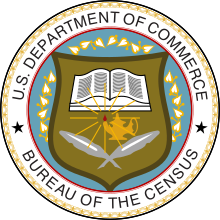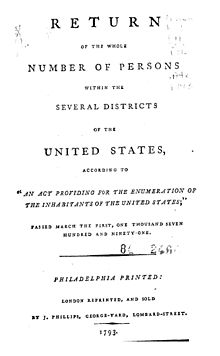1790 United States census
The United States Census of 1790 was the first United States Census. It recorded the population of the United States as of August 2, 1790. In the First Census, the population of the United States was 3,929,214.[1]
| 1790 United States Census | ||
|---|---|---|
| ||
 Seal of the United States Census Bureau | ||
 Title page of 1790 United States Census | ||
| General information | ||
| Country | United States | |
| Results | ||
| Total population | 3,893,635 | |
| Most populous | Virginia 747,610 | |
| Least populous | Delaware 59,094 | |
Data was collected from all thirteen states (Connecticut, Delaware, Georgia, Maryland, Massachusetts, New Hampshire, New Jersey, New York, North Carolina, Pennsylvania, Rhode Island, South Carolina, and Virginia), and districts and territories that would become Vermont, Kentucky, Tennessee, and Maine.[2]
Reaction change
Both Secretary of State Thomas Jefferson and President George Washington didn't fully believe in the results.[3] They believed that there were more people in the United States than what the census said. A reason why there may be more people would be because of the people living farther apart, bad roads that would go to where people may live, limited technology, and people simply not giving any information.
Loss of information change
The records for many states were lost sometime between 1790 and 1830.[4] Almost one third of the original census data have been lost or destroyed since the original census. These include some 1790 data from: Connecticut, Maine, Maryland, Massachusetts, New Hampshire, New York, North Carolina, Pennsylvania, Rhode Island, South Carolina, and Vermont. The data can still be proven in many secondary sources about the first census.[5]
Data change
Census data included the name of the head of the family. They put people into these categories: free white males at least 16 years old (to figure out the country's industrial and military potential), free white males under 16 years old, free white females, all other free persons (reported by sex and color), and slaves.[6] The Secretary of State Thomas Jefferson told marshals to get data from all thirteen states (Connecticut, Delaware, Georgia, Maryland, Massachusetts, New Hampshire, New Jersey, New York, North Carolina, Pennsylvania, Rhode Island, South Carolina, and Virginia), and from the Southwest Territory.[2]
17.8% of the people were slaves. This is the highest percentage of slaves in any American census.
| State | Free white males of 16 years and upward, including heads of families | Free white males under 16 years | Free white females, including heads of families | All other free persons | Slaves | Enslaved % of state population | Total | % of US population |
|---|---|---|---|---|---|---|---|---|
| Vermont | 22,435 | 22,328 | 40,505 | 255 | 16[a][7] | 0.02% | 85,539[b] | 2.2% |
| New Hampshire | 36,086 | 34,851 | 70,160 | 630 | 158 | 0.1% | 141,885 | 3.6% |
| Maine | 24,384 | 24,748 | 46,870 | 538 | 0 | 0.0% | 96,540 | 2.5% |
| Massachusetts | 95,453 | 87,289 | 190,582 | 5,463 | 0 | 0.0% | 378,787[c][8] | 9.7% |
| Rhode Island | 16,019 | 15,799 | 32,652 | 3,407 | 948 | 1.4% | 68,825 | 1.5% |
| Connecticut | 60,523 | 54,403 | 117,448 | 2,808 | 2,764 | 1.2% | 237,946 | 6.1% |
| New York | 83,700 | 78,122 | 152,320 | 4,654 | 21,324 | 6.3% | 340,120 | 8.7% |
| New Jersey | 45,251 | 41,416 | 83,287 | 2,762 | 11,423 | 6.2% | 184,139 | 4.7% |
| Pennsylvania | 110,788 | 106,948 | 206,363 | 6,537 | 3,737 | 0.9% | 434,373 | 11.2% |
| Delaware | 11,783 | 12,143 | 22,384 | 3,899 | 8,887 | 15.0% | 59,094[d] | 1.5% |
| Maryland | 55,915 | 51,339 | 101,395 | 8,043 | 103,036 | 32.2% | 319,728 | 8.2% |
| Virginia | 110,936 | 116,135 | 215,046 | 12,866 | 292,627 | 39.1% | 747,610[e][8] | 19.2% |
| Kentucky | 15,154 | 17,057 | 28,922 | 114 | 12,430 | 16.9% | 73,677 | 1.9% |
| North Carolina | 69,988 | 77,506 | 140,710 | 4,975 | 100,572 | 25.5% | 393,751 | 10.1% |
| South Carolina | 35,576 | 37,722 | 66,880 | 1,801 | 107,094 | 43.0% | 249,073 | 6.4% |
| Georgia | 13,103 | 14,044 | 25,739 | 398 | 29,264 | 35.5% | 82,548 | 2.1% |
| Total | 807,094 | 791,850 | 1,541,263 | 59,150 | 694,280 | 17.8% | 3,893,635 | 99.9% |
- ↑ The census of 1790, published in 1791, reports 16 slaves in Vermont. Subsequently, and up to 1860, the number is given as 17. An examination of the original manuscript allegedly shows that there never were any slaves in Vermont. The original error occurred in preparing the results for publication, when 16 persons, returned as "Free colored", were classified as "Slave". But this claim is disputed by at least one historian.
- ↑ Corrected figures are 85,425, or 114 less than the figures published in 1790, due to an error of addition in the returns for each of the towns of Fairfield, Milton, Shelburne, and Williston, in the county of Chittenden; Brookfield, Newbury, Randolph, and Strafford, in the county of Orange; Castleton, Clarendon, Hubbardton, Poultney, Rutland, Shrewsburg, and Wallingford, in the county of Rutland; Dummerston, Guilford, Halifax, and Westminster, in the county of Windham; and Woodstock, in the county of Windsor.
- ↑ The figures for Massachusetts do not include the population of Maine. Though Maine was then a part of Massachusetts, the Maine figures were compiled separately, and are shown on the line for Maine.
- ↑ Corrected figures are 59,096, or 2 more than figures published in 1790, due to error in addition.
- ↑ The figures for Virginia do not include the population of Kentucky. Though Kentucky was then a part of Virginia, the Kentucky figures were compiled separately, and are shown on the line for Kentucky. The Virginia figures do include the portion of Virginia that later became the state of West Virginia.
City rankings change
References change
- ↑ "History: 1790 Fast Facts". U.S. Census Bureau.
- ↑ 2.0 2.1 "History: 1790 Overview". U.S. Census Bureau.
- ↑ "1790 Overview". U.S. Census Bureau.
- ↑ Dollarhide, William (2001). The Census Book: A Genealogists Guide to Federal Census Facts, Schedules and Indexes. North Salt Lake, Utah: HeritageQuest. p. 7.
- ↑ "1790 Census". 1930 Census Resources for Genealogists.
- ↑ "1790 Census of Population and Housing". U.S. Census Bureau. Archived from the original on April 26, 2015.
- ↑ "Slavery in Vermont".
- ↑ 8.0 8.1 Census Office, United States (1909). "A Century of Population Growth from the First Census of the United States to the Twelfth, 1790–1900". p. 47.
- ↑ Population of the 100 Largest Cities and Other Urban Places in the United States: 1790 to 1990, U.S. Census Bureau, 1998
- ↑ "Regions and Divisions". U.S. Census Bureau. Archived from the original on December 3, 2016. Retrieved September 9, 2016.